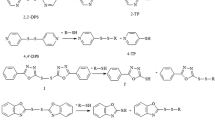Abstract
Moore and Stein1 reported that the reaction of cysteine with ninhydrin is an exception to the general reaction of α-amino-acids with this reagent and the absorption curve of the reaction products is somewhat similar to that of proline and hydroxyproline (Fig. 1). They found that if the neutral protein hydrolysates were allowed to stand at room temperature for 24–28 hr. or if they were adjusted to pH 8 with sodium hydroxide and allowed to stand at room temperature for 4 hr. the cysteine–ninhydrin reaction product gave an absorption spectrum identical to that produced by cystine1,2. It is usual to include cysteine, mercaptoethanol, 2,3-dimercaptopropanol-1 or some other thiol compound as an activator for sulphydryl enzymes. When these are used for the activation of proteolytic enzymes such as ficin and papain the thiol compound (10−2 – 10−3 M solutions) is not completely oxidized to the disulphide during the reaction procedure. The presence of the sulphydryl group then interferes with the usual ninhydrin determination as shown in Table 1 (col. 7). The presence of cysteine introduces two errors; first, during the enzymatic reaction it is partially oxidized to cystine (an unpredictable amount), and second, the cysteine remaining reacts with the ninhydrin reagent to give a red colour which interferes with the quantitative reaction of ninhydrin with the amino-groups. The presence of 0.1 µmole of mercaptoethanol in the modified ninhydrin reaction does not affect the quantitative determination of leucine (Table 1, col. 6), but, if the concentration of this reagent is increased to 10 µmole, leucine does not give a characteristic reaction product having a maximum absorption at 570µ but rather a red colour with an absorption maximum around 450 mµ is produced.
Similar content being viewed by others
References
Moore, S., and Stein, W. H., J. Biol. Chem., 176, 367 (1948).
Stein, W. H., and Moore, S., J. Biol. Chem., 211, 915 (1954).
Thor, C. J. B., and Gortner, R. A., J. Biol. Chem., 99, 383 (1932–33).
Alexander, N. M., Anal. Chem., 30, 1292 (1958).
Roberts, E., and Rouser, G., Anal. Chem., 30, 1291 (1958).
Benesch, R., Benesch, R. E., Gutcho, M., and Laufer, L., Science, 123, 981 (1956).
Hanes, C. S., Hird, F. J. R., and Isherwood, F. A., Nature, 166, 288 (1950).
Moore, S., and Stein, W. H., J. Biol. Chem., 211, 907 (1954).
Author information
Authors and Affiliations
Rights and permissions
About this article
Cite this article
WHITAKER, J. Ninhydrin Assay in the Presence of Thiol Compounds. Nature 189, 662–663 (1961). https://doi.org/10.1038/189662a0
Issue Date:
DOI: https://doi.org/10.1038/189662a0
- Springer Nature Limited




